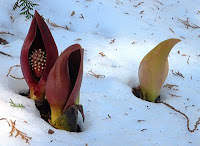 |
| Western Skunk Cabbage (Lysichiton americanus) |
Someone once told me - way back in my theoretically-handsome years - that I looked kinda' like Kenny Loggins, a talented musician of that era (my apologies to Mr. Loggins). And it was a handsome John Ashley (real name "John Atchley"), not me, who starred in the classic movies, “Beach Blanket Bingo” and “Brides of Blood.” While I have consistently displayed a total absence of singing and acting talents, similar looks and similar names can still be a source of confusion.
And so it is for our humble native forb, the Western Skunk Cabbage (Lysichiton americanus). It’s aroma reminds some people of an alluring mixture of skunk, carrion and garlic. Some of us also think it looks a little more handsome and a little less cabbage-like than its distant cousin, the Eastern Skunk Cabbage (Symplocarpus foetidus).
And so it is for our humble native forb, the Western Skunk Cabbage (Lysichiton americanus). It’s aroma reminds some people of an alluring mixture of skunk, carrion and garlic. Some of us also think it looks a little more handsome and a little less cabbage-like than its distant cousin, the Eastern Skunk Cabbage (Symplocarpus foetidus).
But because these two species look similar and have similar names, they can become a source of confusion for people who move east-west, between the native habitats of these two species. And in spite of how handsome our western species might theoretically be, it's the eastern species that is famous (and well-studied) due to its rare heat-managing talents.
WHEN YOU'RE HOT YOU'RE HOT...
All skunk cabbages sprout a club of 100+ tiny flowers on a greenish stem called a "spadix," which starts out wrapped up in a curled, modified leaf called a "spathe." The western species sports a yellow, loose-fitting spathe, while the eastern species' spadix is tightly wrapped in a burgundy spathe. Both species show "sequential hermaphroditism" (or "dichogamy" in botany) meaning that the spadix produces female flowers first before switching over to male flowers, with a brief period of bisexuality - though they seldom self-pollinate. (Who says botany has to be boring?)
Finally, the Western Skunk Cabbage may have lost the talent - if indeed it ever had it - for "thermogenesis" (heat production) and especially "thermoregulation" (maintaining a constant temperature) that is "cause célèbre" for the eastern species. This is another cause for confusion - a few secondary sources credit the western species with thermogenesis, but all of the research on thermoregulation involved only the eastern species.
The Eastern Skunk Cabbage is famous (at least among botanist types) for its fine-tuned thermoregulation, which is quite rare in plants and more commonly associated with mammals. While animal body temps are complex and controlled by the brain, skunk cabbage thermoregulation is managed entirely on a cellular level by those oxygen-burning powerhouses, the mitochondria.
WESTERN SKUNK CABBAGE
 |
| Spadix and spathe |
Skunk Cabbage thrives in wet areas with poor drainage. They flower first before unfurling massive leaves that are the largest of any plant native to Montana. Leaves 2 to 3 feet long were traditionally used by native peoples to wrap salmon for cooking in fire pits, or folded and used like wax paper to make waterproof cups and berry baskets. The plants were mostly eaten only in times of famine, and they had to be thoroughly dried or cooked to break down their toxic chemicals. Skunk cabbage was also used in traditional medicine, most often as a cool poultice for burns and injuries.
The famous Eastern Skunk Cabbage stinks up the early spring bogs and wetlands from Tennesse north through Nova Scotia, often blooming in freezing weather. While flowering, its spadix maintains a temperature of 23°C (73°F), day and night, for more than a week. For every 10°C (38°F) change in air temperature, the spadix only changes 0.9°C (1.6°F) or less. This is the most precise thermostat known among the handful of ancient thermogenic plants.
 |
| Eastern Skunk Cabbage blooming |
The hot female flowers bloom for about 7 days, then there are 2 days of bisexualism (male and female flowers) followed by a male phase for about 17 days. But the spadix only maintains a raised, constant temperature through the female phase, cooling off during the bisexual period, and then back to ambient temperatures as the male phase begins. By the time the male flowers start producing pollen, the female flowers on the same spadix are cold and unreceptive, which prevents self-fertilization. Multiple plants in various stages of blooming are needed for cross-fertilization to occur.
THAT'S COOL, OR HOT, BUT WHY?
 |
| Beetle on pollen-producing spadix |
Higher temps do aid in pollination because female Eastern Swamp Cabbage flowers regulate at the optimal temperature for pollen tube growth (necessary for fertilization). Higher temps also protect the flowers from freezing, but thermoregulating plants evolved in the tropics where such an expensive use of resources would be unnecessary.
It's possible that the original role played by thermoregulation might just be the outdated remains of an ancient adaptation, which might help explain why it persists today in just a handful of plants.
Offers of stinky, heated flowers is an ancient reward for pollination. Late in the Mesozoic era, flowering plants and flying beetles evolved and radiated at a rapid, similar pace. This might suggest the presence of many thermoregulating plants providing warm refuges for a growing number of "cold-blooded" beetle species. But most modern plants now reward pollinators with heat in combustible, caloric form instead - as sweet-smelling calorie-packed nectar.
And so, it's possible that our own Western Skunk Cabbage might have taken an evolutionary step forward by dumping thermogenics. Or, it might have never developed that ability. Like me, sometimes it just gets confused for others with actual talent.

